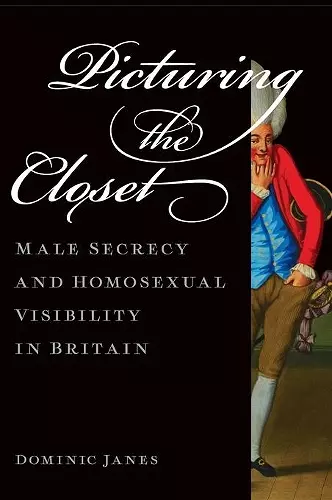Picturing the Closet
Male Secrecy and Homosexual Visibility in Britain
Format:Hardback
Publisher:Oxford University Press Inc
Published:28th May '15
Currently unavailable, and unfortunately no date known when it will be back

To what extent did people think they could identify an 'obvious' sodomite before the construction of the homosexual as a type of person during the latter part of the nineteenth century? What role did secrecy and denial play in relation to the visual expression of same-sex desire before the term 'the closet' came into widespread use in the latter part of the twentieth century? And what, therefore, did sodomites/homosexuals/gays/queers look like in Britain in 1700, 1800, 1900 and 2000? Could they be spotted mincing down the street? Or were such as these just the flamboyant few whose presence conveniently drew attention away from the many others who wanted to appear 'normal'? These issues are not peripheral to the struggle of the last several decades for individual self-determination and self-expression. It was this set of cultural constructions that the pioneering writer Eve Kosofsky Sedgwick (1950-2009) attacked in her book Epistemology of the Closet as representing 'the defining structure for gay oppression in this century'. This book represents a visual culture counterpart to Sedgwick's study and aims, through the use of a series of interdisciplinary case-studies, to explore both the pre-history of the closet since the eighteenth century and its evolution through to the present day. Chapters explore key moments and issues within the British cultural experience and make pioneering use of a wide range of source materials ranging from art to fashion, literature, philosophy, theology, film and archival records.
Far from simply illustrating a pre-existing history of the closet, this fascinating study exploits the potential of visual culture to reveal patterns of expression and obfuscation that exceed the verbal. The result is a compelling argument that the closet pre-existed the articulation of homosexual identity, and offered its own spectacular forms of 'self-fulfillment and expression.' * Christopher Reed, author of Art and Homosexuality: A History of Ideas *
In this wide-ranging, lucid and informative book, Dominic Janes explores the complex visibilities and invisibilities of the male homosexual 'closet' in Britain from the eighteenth century to the present day. His immense range of sources and examples, his nuanced explications, and his sophisticated method will be useful to specialists, and his narrative brio will draw in readers new to the subject. A major achievement in queer cultural history. * Whitney Davis, author of Queer Beauty: Sexuality and Aesthetics from Winckelmann to Freud and Beyond *
This is an ambitious and impressively broad study that reminds us of the importance of aesthetics in considerations of same-sex desire in Britain in the modern period. Janes not only traces the history of the closet, noting its eighteenth century origins, but also reminds us that this literal and metaphorical space was more than a site and symbol of oppression. It was also a space of enormous creativity that produced vitally important ideas and images about both male homosociality and subversive queer subjectivities. * Paul Deslandes, author of Oxbridge Men: British Masculinity and the Undergraduate Experience, 1850-1920 *
Picturing the Closet offers a compelling and nuanced history of the border zones in which men's desires for each other were signaled and recognized. Dominic Janes's illuminating and wide-ranging assessment of the structuring roles of desire, dissemblance, and disclosure is an important contribution to the study of British visual culture since the eighteenth century. * David J. Getsy, author of Rodin: Sex and the Making of Modern Sculpture *
ISBN: 9780190205638
Dimensions: 178mm x 254mm x 20mm
Weight: 703g
240 pages